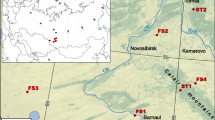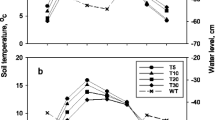Abstract
The investigation of belowground plant production and its determining factors is critical for better understanding carbon turnover in the biosphere. The measurement of fine root production is a methodical and difficult task. To reveal factors determining fine root production in mountain ecosystems, we introduced a new modification of ingrowth method with the use of filter balls (tea strainers). We studied root production in 16 communities from upper forest to subnival belts in the range of 2184–3069 m a.s.l. in the Teberda Reserve, Northwestern Caucasus, Russia. The filter balls were filled with sifted soil (without roots or stones) and buried in the soil 7–8 cm deep. The mass of root ingrowth was measured after two months of incubation under natural conditions. Mixed-effect models were applied to test the relationships between root mass, elevation, soil moisture, organic matter content, and pH. The highest root production was observed in an alpine snowbed (247 mg per filter ball in 60 days), the lowest was in forest and subnival communities (3–20 mg per filter ball in 60 days). The communities with woody dominants had lower production than herb communities. It increased with soil moisture, which was the most important factor. In herb communities the production of roots tended to decrease with the elevation. Soil organic matter as a separate factor had a positive relationship with root production in herb communities. There were no links between root ingrowth and soil pH. The method introduced presently both allows for the comparison of plant communities by their root production and reveals factors determining it.


Similar content being viewed by others
REFERENCES
Abramoff, R.Z. and Finzi, A.C., Are above- and belowground phenology in sync?, New Phytol., 2015, vol. 205, no. 3, pp. 1054–1061.
Alpine Ecosystems in the Northwest Caucasus, Onipchenko, V.G., Ed., Dordrecht: Kluwer, 2004.
Alvarez-Uria, P. and Körner, C., Low temperature limits of root growth in deciduous and evergreen temperate tree species, Funct. Ecol., 2007, vol. 21, no. 2, pp. 211–218.
Arthur, M.A. and Fahey, T.J., Biomass and nutrients in an Englemann spruce-subalpine fir forest in the north central Colorado: Pools, annual production, and internal cycling, Can. J. For. Res., 1992, vol. 22, no. 3, pp. 315–325.
Balogianni, V.G., Blume-Werry, G., and Wilson, S.D., Root production in contrasting ecosystems: The impact of rhizotron sampling frequency, Plant Ecol., 2016, vol. 217, no. 11, pp. 1359–1367.
Bartoń, K., MuMIn: Multi-Model Inference. R Package Version 1.40.0, 2017. https://CRAN.R-project.org/ package=MuMIn.
Blume-Werry, G., Wilson, S.D., Kreyling, J., and Milbau, A., The hidden season: Growing season is 50% longer below than above ground along an arctic elevation gradient, New Phytol., 2016, vol. 209, no. 3, pp. 978–986.
Böhm, W., Methods of Studying Root Systems, Berlin: Springer, 1979.
Cheng, L., Chen, W., Adams, T., Wei, X., Li, L., Mccormack, M.L., Deforest, J.L., Koide, R.T., and Eissenstat, D.M., Mycorrhizal fungi and roots are complementary in foraging within nutrient patches, Ecology, 2016, vol. 97, no. 10, pp. 2815–2823.
de Kroon, H., Mommer, L., and Nishiwaki, A., Root competition: Towards a mechanistic understanding, in Root Ecology, de Kroon, H. and Visser, E.J.W., Eds., Berlin: Springer, 2003, pp. 215–234.
Fox, J. and Weisberg, S., An {R} Companion to Applied Regression, Thousand Oaks, CA: Sage, 2011, 2nd ed. http:// socserv.socsci.mcmaster.ca/jfox/Books/Companion.
Fukuzawa, K., Dannoura, M., and Shibata, H., Fine root dynamics and root respiration, in Measuring Roots: An Updated Approach, Marcuso, S., Eds., Heidelberg: Springer, 2012, pp. 291–302.
Ghabbour, E.A., Davies, G., Cuozzo, N.P., and Miller, R.O., Optimized conditions for determination of total soil organic matter in diverse samples by mass loss on ignition, J. Plant Nutr. Soil Sci., 2014, vol. 177, no. 6, pp. 914–919.
Gill, R.A. and Jackson, R.B., Global pattern of root turnover for terrestrial ecosystems, New Phytol., 2000, vol. 147, no. 1, pp. 13–31.
Graefe, S., Hertel, D., and Leuschner, C., N, P and K limitation of fine root growth along an elevation transect in tropical mountain forests, Acta Oecol., 2010, vol. 36, no. 6, pp. 537–542.
Gross, N., Robson, T.M., Lavorel, S., Albert, C., Le Bagousse-Pinguet, Y., and Guillemin, R., Plant response traits mediate the effects of subalpine grasslands on soil moisture, New Phytol., 2008, vol. 180, no. 3, pp. 652–662.
Hertel, D. and Leuschner, C., A comparison of four different fine root production estimates with ecosystem carbon balance data in a Fagus-Quercus mixed forest, Plant Soil, 2002, vol. 239, no. 2, pp. 237–251.
Hui, D. and Jackson, R.B., Geographical and interannual variability in biomass partitioning in grassland ecosystems: a synthesis of field data, New Phytol., 2006, vol. 169, no. 1, pp. 85–93.
Iversen, C.M., Sloan, V.L., Sullivan, P.F., Euskirchen, E.S., McGuire, A.D., Norby, R.J., Walker, A.P., Warren, J.M., and Wullschleger, S.D., The unseen iceberg: Plant roots in Arctic tundra, New Phytol., 2015, vol. 205, no. 1, pp. 34–58.
Körner, C., Alpine Plant Life: Functional Plant Ecology of High Mountain Ecosystems, Berlin: Springer, 2003, 2nd ed.
Körner, C., Alpine Treelines: Functional Ecology of the Global High Elevation Tree Limits, Basel: Springer, 2012.
Körner, C. and Renhardt, U., Dry matter partitioning and root/leaf area ratios in herbaceous perennial plants with diverse altitudinal distribution, Oecologia, 1987, vol. 74, no. 3, pp. 411–418.
Lauenroth, W.K. and Gill, R., Turnover of root systems, in Root Ecology, de Kroon, H. and Visser, E.J.W., Eds., Berlin-Heidelberg: Springer, 2003, pp. 61–89.
McCormack, M.L., Dickie, I.A., Eissenstat, D.M., Fahey, T.J., Fernandez, C.W., Guo, D., Helmisaari, H.-S., Hobbie, E.A., Iversen, C.M., Jackson, R.B., Leppälammi-Kujansuu, J., Norby, R.J., Phillips, R.P., Pregitzer, K.S., Pritchard, S.G., Rewald, B., and Zadworny, M., Redefining fine roots improves understanding of below-ground contributions to terrestrial biosphere processes, New Phytol., 2015, vol. 207, no. 3, pp. 505–518.
Milchunas, D.G., Estimating root production: Comparison of 11 methods in shortgrass steppe and review of biases, Ecosystems, 2009, vol. 12, no. 8, pp. 1381–1402.
Milchunas, D.G., Biases and errors associated with different root production methods and their effects on field estimates of belowground net primary production, in Measuring Roots: An Updated Approach, Marcuso, S., Ed., Heidelberg: Springer, 2012, pp. 303–339.
Moar, S.E.L. and Wilson, S.D., Root responses to nutrient patches in grassland forest, Plant Ecol., 2006, vol. 184, no. 1, pp. 157–162.
Mommer, L. and Weemstra, M., The role of roots in the resource economics spectrum, New Phytol., 2012, vol. 195, no. 4, pp. 725–727.
Montagnoli, A., Terzaghi, M., Scippa, G.S., and Chiatante, D., Heterorhizy can lead to underestimation of fine-root production when using mesh-based techniques, Acta Oecol., 2014, vol. 59, no. 1, pp. 84–90.
Nagelmuller, S., Hiltbrunner, E., and Körner, C., Critically low soil temperatures for root growth and root morphology in three alpine plant species, Alp. Bot., 2016, vol. 126, no. 1, pp. 11–21.
Nakagawa, S. and Schielzeth, H., A general and simple method for obtaining R2 from generalized linear mixed-effects models, Methods Ecol. Evol., 2013, vol. 4, no. 2, pp. 133–142.
Ni, J., Estimation net primary productivity of grasslands from field biomass measurements in temperate northern China, Plant Ecol., 2004, vol. 174, no. 2, pp. 217–234.
Okada, K., Aiba, S., and Kitayama, K., Influence of temperature and soil nitrogen and phosphorus availabilities on fine-root productivity in tropical rainforests on Mount Kinabalu, Borneo, Ecol. Res., 2017, vol. 32, no. 2, pp. 145–156.
Onipchenko, V.G., Phytomass of the alpine communities in the North-Western Caucasus, Byull. Mosk. O-va. Ispyt. Prir., Otd. Biol., 1990, vol. 95, no. 6, pp. 52–62.
Onipchenko, V.G., Alpine vegetation of the Teberda Reserve, the Northwest Caucasus, in Veroffentlichungen des Geobotanischen Institutes der ETH, Zurich: Stiftung Rubel, 2002, no. 130.
Onipchenko, V.G., Zernov, A.S., and Vorobéva, F.M., Vascular plants of Teberda Reserve (annotated list of species), in Flora and Fauna of Natural Reserves, Moscow: MAKS Press, 2011, vol. 99A.
Onipchenko, V.G., Kipkeev, A.M., Makarov, M.I., Kozhevnikova, A.D., Ivanov, V.B., Soudzilovskaia, N.A., Tekeev, D.K., Salpagarova, F.S., Werger, M.J.A., and Cornelissen, J.H.C., Digging deep to open the white black box of snow root phenology, Ecol. Res., 2014, vol. 29, no. 4, pp. 529–534.
Osawa, A. and Aizawa, R., A new approach to estimate fine root production, mortality, and decomposition using litter bag experiments and soil core techniques, Plant Soil, 2012, vol. 355, nos. 1–2, pp. 167–181.
Pinheiro, J., Bates, D., DebRoy, S., and Sarkar, D., R Core Team. nlme: Linear and Nonlinear Mixed Effects Models. R Package Version 3.1-121, 2015. http://CRAN.R-project.org/package=nlme.
R Core Team, R: A Language and Environment for Statistical Computing, Vienna: R Foundation for Statistical Computing, 2015. https://www.R-project.org/.
Santantonio, D. and Hermann, R.K., Standing crop, production, and turnover of fine roots on dry, moderate, and wet sites of mature Douglas-fir in western Oregon, Ann. For. Sci., 1985, vol. 42, no. 2, pp. 113–142.
Schwieger, S., Kreyling, J., Milbau, A., and Blume-Werry, G., Autumnal warming does not change root phenology in two contrasting vegetation types of subarctic tundra, Plant Soil, 2018, vol. 424, nos. 1–2, pp. 145–156.
Sloan, V.L., Fletcher, B.J., and Phoenix, G.K., Contrasting synchrony in root and leaf phenology across multiple sub-Arctic plant communities, J. Ecol., 2016, vol. 104, no. 1, pp. 239–248.
Steinaker, D.F. and Wilson, S.D., Phenology of fine roots and leaves in forest and grassland, J. Ecol., 2008, vol. 96, no. 6, pp. 1222–1229.
Stevens, G.N. and Jones, R.H., Patterns in soil fertility and root herbivory interact to influence fine-root dynamics, Ecology, 2006, vol. 87, no. 3, pp. 616–624.
Stewart, A.M. and Frank, D.A., Short sampling intervals reveal very rapid root turnover in a temperate grassland, Oecologia, 2008, vol. 157, no. 3, pp. 453–458.
Sullivan, P.F., Sommerkorn, M., Rueth, H.M., Nadelhoffer, K.J., Shaver, G.R., and Welker, J.M., Climate and species affect fine root production with long-term fertilization in acidic tussock tundra near Toolik Lake, Alaska, Oecologia, 2007, vol. 153, no. 3, pp. 643–652.
Tang, Z., Dend, L., An H., and Shangguan, Z., Bayesian method predicts belowground biomass of natural grasslands, Écoscience, 2017, vol. 24, nos. 3–4, pp. 127–136.
Vamerali, T., Bandiera, M., and Mosca, G., Minirhizotrons in modern root studies, in Measuring Roots: An Updated Approach, Marcuso, S., Eds., Heidelberg: Springer, 2012, pp. 341–361.
van der Krift, T.A.J. and Berendse, F., Root life spans of four grass species from habitats differing in nutrient availability, Funct. Ecol., 2002, vol. 16, no. 2, pp. 198–203.
Vertelina, O.S., Onipchenko, V.G., and Makarov, M.I., Primary minerals and processes of weathering in high-mountain soils of the Teberda Reserve, Moscow Univ. Soil Sci. Bull., 1996, vol. 51, no. 1, pp. 1–8.
Volkov, A.V., Soil-vegetation relationships in alpine zone of the Teberda reserve, Trans. Teberda Reserve, 1999, vol. 15, pp. 14–40.
Wu, Y., Deng, Y., Zhang, J., Wu, J., Tang, Y., Cao, G., Zhang, F., and Cui, X., Root size and soil environments determine root lifespan: Evidence from an alpine meadow on the Tibetan Plateau, Ecol. Res., 2013, vol. 28, no. 3, pp. 493–501.
ACKNOWLEDGMENTS
We are grateful to G. Matyshak for assistance with soil analysis.
Funding
This study was supported by the Russian Science Foundation, project no. 19-14-00038.
Author information
Authors and Affiliations
Corresponding author
Ethics declarations
Conflict of interests. The authors declare that they have no conflicts of interest.
Statement on the welfare of humans or animals. This article does not contain any studies involving humans or animals performed by any of the authors.
Rights and permissions
About this article
Cite this article
Onipchenko, V.G., Gulov, D.M., Ishbirdin, A.R. et al. Analysis of Fine Root Production Features in High Mountain Communities by Ingrowth Method using Filter Balls. Contemp. Probl. Ecol. 14, 456–464 (2021). https://doi.org/10.1134/S1995425521050085
Received:
Revised:
Accepted:
Published:
Issue Date:
DOI: https://doi.org/10.1134/S1995425521050085




